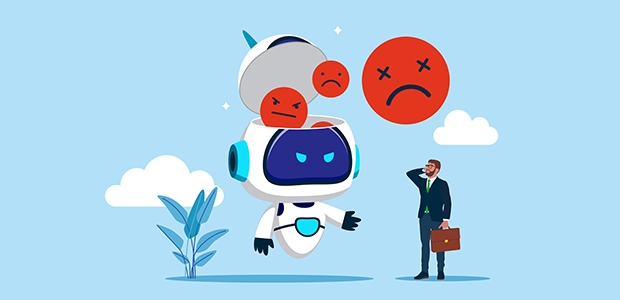
Your business is not ready for the AI economy
The internet is undergoing a profound transformation, shifting from a human-centric interaction paradigm to one increasingly mediated by autonomous AI agents. This "agentic revolution" necessitates a radical rethinking of product design patterns and business models. Companies that fail to cater to a growing number of machine internet "users" risk not just a decline in usage, but complete invisibility in the AI economy.
Traditionally, an internet product’s success has been predicated on capturing human attention – guiding users through intuitive interfaces, and optimising for clicks and conversions. However, the rise of sophisticated AI agents capable of navigating multi-step workflows and leveraging external tools through emerging interoperability standards such as MCP and Agent2Agent, shatters this notion.
Modern AI agents are not aimless scraper bots of old; they are becoming the primary layer through which humans interact with the digital world – making decisions on behalf of users about what to buy, where to buy it, and how. Adobe Analytics reported a staggering 1,200% increase in traffic to retailer websites from generative AI sources between July 2024 and February 2025, underscoring the rapid proliferation of AI-orchestrated purchasing journeys.
The implications of this agentic revolution are profound. The traditional customer journey, once initiated by a human typing a query into a search bar, now often begins with an AI agent determining which products are even worthy of consideration based on a prompt supplied by their human user. Unless a vendor’s catalogue is callable, parsable, and comparable by these agents, it will simply never enter the consideration funnel.
For years, product leaders have been focused on keeping bots out – building CAPTCHAs, logic puzzles, and anti-scraping defences to protect their platforms from non-human use. Winning in an agent-driven world demands the opposite: exposing functionality and building systems that software programs can navigate without explicit human control or direction.
Enter: agent experience
AI agents do not "browse" the internet in the human sense. They interpret it by parsing structured data, querying APIs and MCP servers, and incorporating those sources to help them complete whatever task they’ve been prompted to do. When a human delegates a task – be it finding a hotel, ordering inventory, or locating the best deal on sneakers – the AI agent representing that person’s directive effectively becomes the customer.
Fulfilling these machine customers' needs requires a new discipline: Agent Experience (AX).
AX teams, emerging as critical counterparts to traditional UX teams, will not toil over polished graphical interfaces or interaction models. Instead, their focus will be on backend usability. This includes:
- Schema design: crafting clear, unambiguous data schemas that agents can readily discover and ingest
- Machine-readable documentation: providing comprehensive documentation for APIs or MCP tools that agents can load into context
- Permissioning: establishing granular access controls that allow agents to interact with their system while maintaining robust security
- Agent testing: rigorously testing product functionality from an agent's perspective, ensuring seamless machine interoperability and agent success
If UX shapes how humans use a product, AX shapes how machines act through it. As Salesforce notes, "Agent experience design (AX) should result in great usability for and of agents. Thus, great AX leads to great user experience (UX)".
Monetisation and business model evolution
The agent-driven economy also necessitates new monetisation frameworks. Traditional business models heavily reliant on engagement metrics and human-driven conversions will face severe drop-offs. AI isn't emotional; it runs on data, and loyalty, in the human sense, disappears once a purchasing task is completed.
In this new paradigm, revenue will increasingly flow from utility, not engagement. The revenue streams of the AI economy will be:
- Access monetisation: volume-based pricing or affiliate commissions for integrations that agents can use to help fulfil user needs
- Ecosystem placement: securing preferred placement and integrations within popular root interfaces, such as Perplexity, ChatGPT, or Claude
To thrive in this agent-first environment, organisations require significant structural change. Product managers will need to prioritise machine-accessibility as much as human-facing functionality exposed through graphical interfaces. Marketing teams must rethink attribution in an "invisible funnel," where the customer is an agent, not a human. Security teams will shift from blocking bot traffic to governing and enabling legitimate agent interactions. Growth itself will become a question of machine discoverability and interoperability.
Leading companies are already treating agent access as a core component of their go-to-market strategy. Instead of forcing users into proprietary apps to access their offerings, they are investing heavily in robust AX. They are embracing that the application, contained in a traditional GUI, becomes secondary in an agentic future, and recognising that their future-proof value proposition is to serve as a machine-usable backend.
The window of opportunity
The shift to an agent-driven digital world is not a distant dream; it is already underway. Forecasts suggest that by 2030, over 55% of purchases will be driven by AI-friendly consumers, with AI enthusiasts wielding over $4 trillion in buying power in the US alone.
Companies still have a critical window to “get with the programs.” The first step is to conduct a comprehensive "agent accessibility" audit of existing products and platforms. This will involve exposing the backend to remove unnecessary blockers that hinders legitimate machine access; and removing friction to make a platform callable, parsable, and useful.
When the agentic revolution is done, only those products engineered for agent-first interaction will remain in the consideration set of most human consumers. The human-friendly layer will not disappear, but it will move down the stack, with agents handling the bulk of discovery, comparison, and purchasing. In this new era, the ultimate success metric will be whether a machine can interpret what your product does and integrate or recommend it with ease.
For more startup news, check out the other articles on the website, and subscribe to the magazine for free. Listen to The Cereal Entrepreneur podcast for more interviews with entrepreneurs and big-hitters in the startup ecosystem.

